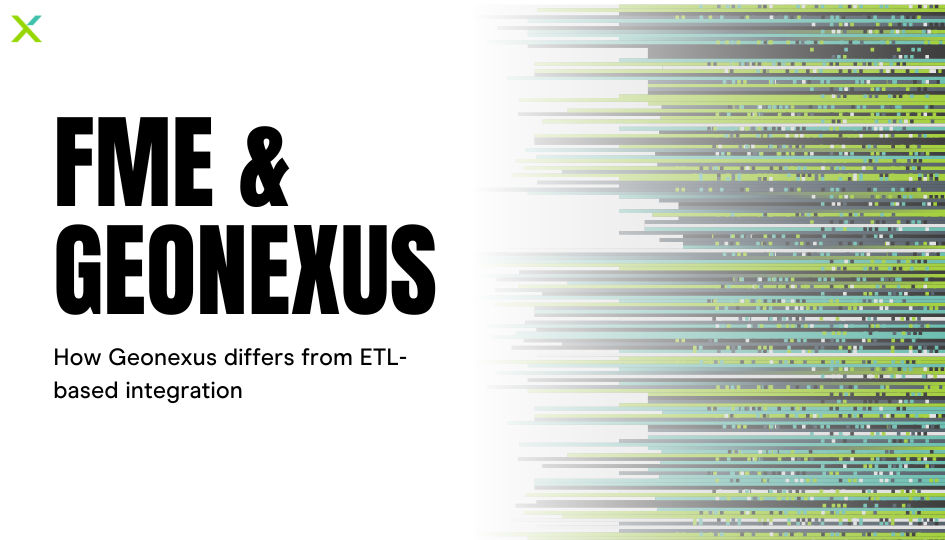
Safe Software’s FME was one of the first tools on the market designed for GIS integration. It uses the “extract, transform, and load” (ETL) methodology to integrate spatial data – a different approach than the one used by the Geonexus Integration Platform (GIP). Although the two solutions aren’t alike in their data integration approaches, there are a few key similarities between the two platforms. There are also fundamental differences, all of which will be covered in this blog.
Before FME came around, it was very difficult to transfer geospatial data between systems. FME was designed to overcome the myriad problems associated with traditional data translation methods. The data integration features FME provided were made possible by a Python Interpreter, which essentially used Python scripts to perform the data translations necessary for FME’s version of data integration.
Nowadays, FME has grown beyond simple geospatial integration. It now supports more data formats and transformation capabilities and is capable of manipulating data from those sources for use within ArcGIS or other Esri products. Common FME use cases include importing and manipulating Excel, CAD, LiDAR, and XML data for use with Esri software.
There are a few similarities between FME and Geonexus, like the fact that both systems were designed to eliminate the need for custom-code integrations. Additionally, both systems allow integration configuration through graphical user interfaces (GUIs) instead of command lines. Geonexus and FME also started off as GIS integration tools, but over time both platforms have evolved to support more data types and enterprise systems.
But that’s where the similarities end. FME has been around for a long time, but it isn’t the best choice for integration anymore. There are a few reasons for this:
The Geonexus Integration Platform does not utilize the ETL method – it’s a middleware integration platform featuring a library of connectors that are compatible with popular GIS, CIS, and EAM systems like ArcGIS, IBM Maximo, SAP, and more. GIP utilizes REST APIs to connect with these systems, which means you can set up an integration with little to no code required. The Geonexus Integration Platform also supports multipoint, bidirectional synchronization to any systems in our library of connectors.
GIP is full of features that can help you save time in your day-to-day workflow. Our user-friendly GUI makes it easy to set up and configure your integration whenever changes need to be made. Additionally, the Geonexus Integration Platform creates comprehensive data reports that give you a complete overview of your data’s health every time your data is synchronized. These reports (exportable in PDF or XML formats) automatically track creations, deletions, duplications, and discrepancies in your data, so no change goes unnoticed. Most importantly, these reports don’t need to be created from scratch by users.
As mentioned in a recent blog (link when posted), the Geonexus Integration Platform can also align data from the Geometric Network and Utility Network models without the need to extract and reload all the data from both systems. This enables your organization to leverage GN-based legacy applications and make the move to the UN at your own pace.
This list of features isn’t exhaustive by any means. For a more in-depth list of Geonexus Integration Platform features, check out our platform overview or one of our white papers.
If you’re looking for an ETL tool to help with your data migration needs, FME is a solid option that’s already being used by several Geonexus customers. But, it’s important to know that FME is not capable of data integration on the level that the Geonexus Integration Platform is when comparing the amount of development required to configure an integration. Features like automatic reporting, multipoint integration, and GN-UN alignment are just a few examples of how the Geonexus Integration Platform’s feature set goes beyond FME’s.
To answer the question posed in the title: No, FME and the Geonexus Integration Platform aren’t foes. In fact, they’re far from it! They’re different systems designed for different purposes, and they both have their uses in the ever-expanding world of asset management.
At Geonexus our mission is to ensure integrity and reliability of enterprise data to support effective decision making. Our Integration Platform is an enterprise-grade integration solution that is easy to use, reliable, and includes out-of-the-box connectors for Esri® ArcGIS®, IBM® Maximo, SAP®, ABB® Ellipse, Oracle® Utilities, and other leading enterprise systems. Asset-intensive organizations across the globe use the Geonexus Integration Platform in industries including utilities, telecommunications, pipeline, transportation, and government.